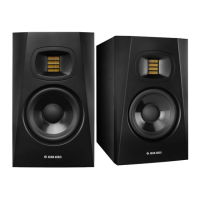14
T SERIES MANUAL [ENGLISH]
6. USING THE HF AND LF SWITCHES ON
THE REAR PANEL
On the rear panel for each T Series monitor, two 3-way switches labeled “LF” and “HF”
boost or cut the monitor’s respective high- and low-frequency responses by 2 dB. Each
switch also provides a neutral middle position, labeled “0,” that produces flat response
in their frequency range. If you’ve placed your T Series monitors optimally [see Section
2 of this manual], you’ll probably find that your T Series monitors sound the most
balanced
with both switches set to the “0” [flat] position.
A brief review of how room acoustics can affect loudspeaker performance will help you
get the most out of using your T Series monitors’ LF and HF switches:
Sound bouncing off bare walls and, typically to a lesser extent, the ceiling in your
control
room can create very short echoes that distort imaging and phase response
back at your mix position. Properly treating your room with acoustic foam or high-
density fiberglass sound panels reduces or prevents these problems by absorbing the
sound, rather than reflecting it back to your mix position. However, foam and fiberglass
sound panels absorb mostly high, midrange and—depending on the material used and
its thickness—upper-bass frequencies. [The thicker the material, the lower the extension
of frequencies that are absorbed, with high-density fiberglass absorbing frequencies
roughly a full octave lower than open-cell foam for the same thickness. For example,
both 2”-thick fiberglass wall panels and 4”-thick acoustic foam typically absorb sound
effectively down to around 250 Hz.] Because these materials absorb sound most effectively
in the treble range, a room heavily treated with acoustic foam or fiberglass sound
panels can make any loudspeaker’s playback of high frequencies sound muffled. To
re
store clarity and detail, your T Series monitors provide a HF switch setting that boosts
high-frequency response 2 dB.
Another acoustic phenomenon to keep in mind when placing your monitors in your
room is the boundary effect. The closer you place a loudspeaker to a room boundary
— a wall, floor or ceiling — the more bass frequencies will be acoustically boosted. To
preserve your T Series monitors’ flat frequency response, it’s important to nullify the
boundary effect by placing them at least 16 inches away from any wall. This is also
im
portant in order to prevent physical interference by the wall behind the monitors with
the cabinets’ rear-firing bass reflex ports. If ergonomics require you place your T Series
monitors close to a wall, setting the LF switch on the rear panel to the “-2 dB” setting
will cut the bass response an equal amount and help restore flat spectral balance.

